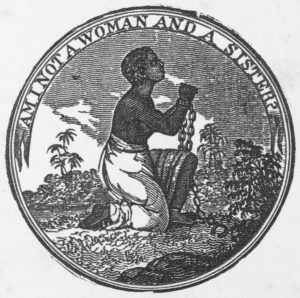Story by Katie Knowles

Donated by Pat L. Nickols, 2016.48.5r
The quilt block pictured here is currently on view at the Avenir Museum in our exhibition R.E.S.P.E.C.T. the Dress: Clothing and Activism in U.S. Women’s History (Jan. 21-May 23, 2020). Clothing and other textiles like quilts play an important role in the country’s history of women’s rights. Many activists were involved in a variety of social justice initiatives of their times.
In the decades leading up to the American Civil War (1861-1865), perhaps the largest common cause was that of the anti-slavery and abolition movement. Black and white women and men organized, petitioned, and resisted the system of chattel slavery prevalent in the United States since the country’s colonial era. Some used clothing as a way to resist by refusing to buy and wear cotton fabrics made using enslaved labor.
Quilt block
This quilt block was cut from a larger signature quilt made and signed by members of the Religious Society of Friends in 1842 likely from the southeastern part of Pennsylvania. The Friends, often called Quakers, are a predominantly Christian-based religious sect who believe that each person carries an inner light, or divine presence, within them. This core message of their faith resulted in relatively egalitarian roles for women and a respect for the sanctity of the lives of all people compared to general social practices of the 1800s.
Many Quakers supported the abolition of chattel slavery, believing that no person should be enslaved as each person’s soul holds the presence of divinity. The stamped image at the middle of this block includes a kneeling man wearing chains around his wrists. His hands are held up pleading for assistance. Underneath him is a quote from Psalm 119:134 of the Christian Bible: “Deliver me from the oppression of man.”
Abolitionist print

Versions of the “kneeling slave” abolitionist print depicting a man or a woman circulated widely in the early 1800s, casting enslaved people as helpless and in need of saving despite the millions of enslaved men and women who liberated themselves, several of whom went on to lead anti-slavery organizations. Abolitionists held craft fairs frequently where they sold small handmade gift items featuring anti-slavery imagery and sayings.
Many of the goods sold were decorative textiles made by women such as book marks, pillow covers, and wall hangings. The money these fairs raised supported abolitionist organizations, sometimes including financial support for those attempting to or recently escaped from slavery. Textiles like this quilt block expressing one community’s support for abolition survive as a testament to the anti-slavery cause and to the centrality of fabric in understanding our nation’s history.
The Avenir Museum of Design and Merchandising is in the Department of Design and Merchandising, part of CSU’s College of Health and Human Sciences.